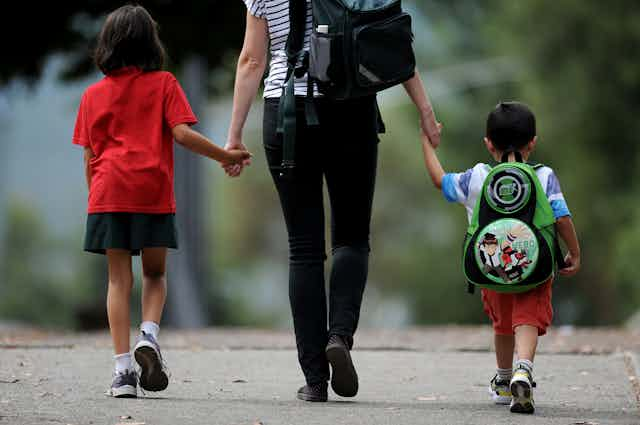Australian primary schools are becoming increasingly reliant on commercial programs for teaching students. This means the content and the way students are being taught is outsourced to a third-party provider, who is not your child’s teacher.
Pre-pandemic research, commissioned by the New South Wales Teachers Federation in 2017 showed 28% of the state’s public school teachers already regularly used commercial products. We know the use of commercial programs increased since the start of COVID with increasing demands on schools.
The use of programs has grown to the point where some state education departments provide guidance about their use and even have endorsed resources.
These programs may seem like a good solution when teaching resources are stretched and the community demands evidence of learning progress. But their use can threaten children’s engagement in learning and undermine the value of professional teaching staff.
Read more: Why is tech giant Apple trying to teach our teachers?
What are commercial programs?
These are programs developed by commercial organisations and sold to schools in prepackaged form. Some parents may already be familiar with literacy programs used to teach reading. But commercial programs are developed and sold across all areas of the curriculum.
Packages include programs of work with prescribed lessons and timing for delivery. They can even include scripts for teachers to read aloud during lessons. Teachers are trained how to use these programs by the provider. They are told it will only be effective if they copy the provider’s content and methods.
The developers also advocate a “whole school” approach, which means the program is taught across all year levels and incorporates its assessment tools, interventions and extension programs.
The cost to schools can be thousands of dollars, plus associated resources like worksheets and tests, and professional development. They are paid for out of school budgets via both government funding and school fees.

Why are schools using commercial programs?
The use of commercial programs in Australian schools has increased dramatically over the last 15 years since the introduction of NAPLAN and publication of test results on the MySchool website.
More transparency around school performance was intended to empower parents to make informed choices and drive school improvement. However, pressure to prove a school’s academic performance has created urgency for schools to find strategies that will give them a competitive edge.
At the same time, there has been a broader, global shift in education towards standardisation, high-stakes accountability and the use of corporate management models.
It is easy to see why schools use commercial programs. They offer efficient, consistent delivery of content across year levels. They also save teachers planning time and come with ready-made resources for lessons.
But schools often adopt these programs to reduce workload or because they have become widely accepted by other schools, rather than investigating whether they are endorsed and peer-reviewed by Australian or international education experts.
Read more: The rise of ChatGPT shows why we need a clearer approach to technology in schools
Why is it a problem?
Most commercial programs claim to be “evidence-based”. But this can be based on small, selective or inadequate research that cannot be generalised to all students.
They may rely on “direct instruction” teaching methods – where the teacher stands at the front and instructs students – and prioritise a quick pace for rapid academic gains.
This is despite broad understanding that hands-on, play-based experiences support meaningful learning and are more inclusive in the classroom.
Commercial programs also require teachers to “trust the program”, which can limit the teacher’s capacity to meet individual children’s needs.
Some schools and early learning centres now deliver commercial programs in the preschool years despite National Quality Standards requiring educators to respond to children’s own ideas and play, and personalise interactions.
All the while, it is taking autonomy away from teachers, while devaluing their professional knowledge and skills.
Reliance on commercially driven third parties is at odds with the evidence-based training teachers receive at university. It also makes it harder for education students to develop essential teaching and programming skills during their professional placements.

What do parents need to know?
It is important parents ask who (or what) is behind their child’s learning at school.
Commercial programs are inherently generic and may rely on teaching methods including repetition of content and skills, often without opportunity for “real life” application that sustains children’s motivation to learn.
This can have an impact on a child’s engagement at school, because they are being “talked at” rather than allowed to explore ideas and develop thinking and communication skills that lead to understanding.
Particularly in the early years of school, homogeneous teaching makes it harder for children to learn at their natural pace – and to support their social and emotional development.
Schools need to be transparent about the commercial programs they adopt so parents are aware of the costs, how the programs are delivered, and what that means for their child’s engagement in learning on a daily basis.
Read more: As more biometric data is collected in schools, parents need to ask these 10 questions

